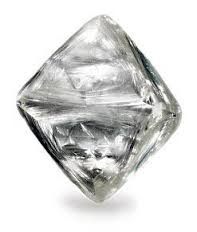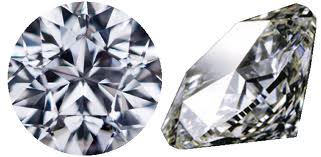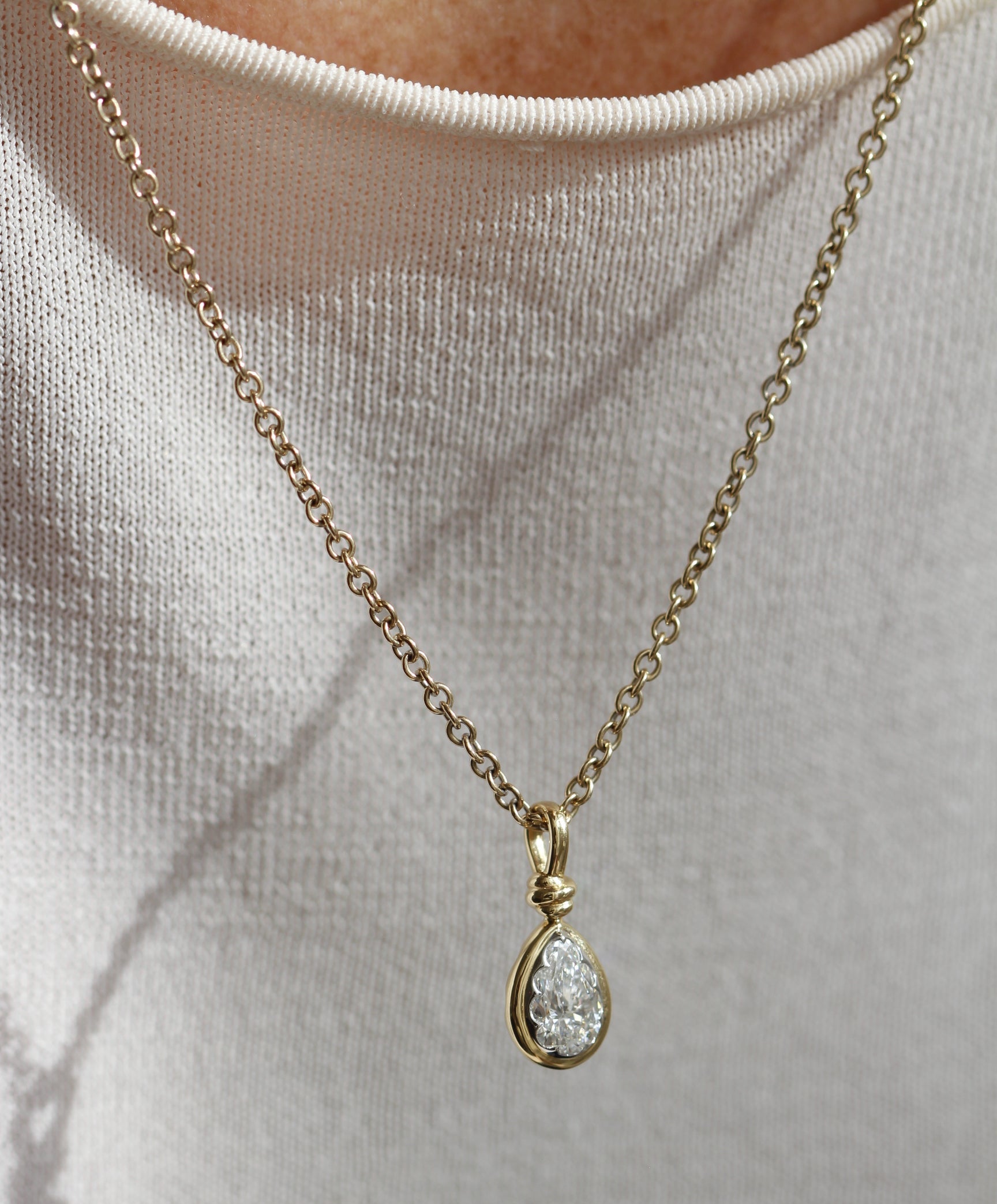Diamond Education
Diamonds have been mysteriously forged from within the earth approximately 3500 million years ago. They have always been prized for their rarity as well as being symbols of enchantment and love.
Diamonds are not difficult or complicated to purchase if you understand the key aspects of quality. A simple way to assess the quality of a diamond is the ‘4 Cs’ - cut, colour, clarity and carat weight. Determining the shape of the diamond is also a very important decision.
The 4 C’s
1. Cut
The cut of a diamond describes the technique in which a diamond has been shaped and polished from its beginning form as a rough stone to its final proportions. Image below of a rough diamond prior to cutting.
Diamonds with a high cut grade will have a high degree of brightness and sparkle.
There are mathematical guidelines for the angles and length ratios at which the diamond should be cut in order to reflect the maximum amount of light. Round brilliant diamonds, the most common, are guided by these specific guidelines, though fancy cut stones are not able to be as accurately guided by mathematical specifics.
The most frequent mistakes by the diamond cutters when cutting a round brilliant cut diamond are listed below, some of these are also relevant with fancy cut diamonds;
- An incorrect number of facets
- A thick girdle creating excessive weight. It is easy to mistakenly believe that the number of carats is the most important aspect to a diamonds value, one common mistake is to leave too thick a girdle. This gives the diamond a higher price however it also diminishes the brilliance and beauty.
- The ‘nail head’ effect. This is caused when a diamond is cut too deep, if you look at the stone from the top a dark nail head may appear in the center of the stone.
- The ‘large angle’ effect is when the table of the diamond is too large, the stone is dulled. Even worse, it produces an unattractive large angle effect across the crown.
At Orsini’s we believe that the cut is crucial as this is where the beauty and brilliance of a diamond is reflected. Diamonds should always be ‘cut for beauty not weight’. Sarah has expert diamond knowledge and endeavors to select diamond that have been very well cut 'excellent cut grade' to ensure maximum sparkle.
Round brilliant diamond after the cutting process below
2. Colour
Colour is also an important aspect to be considered with when buying a diamond. The Gemological Institute of America (GIA) set an alphabet scale as the colour- grading standard. The best and most expensive diamonds are rated D, and the lower quality diamonds are rated Z. Using the G.I.A. colour grading scale, the average colour grades are ‘H I J’ as underlined below.
D E F G H I J K L M N O P Q R S T U V W X Y Z
Diamonds that are closer to the D end of the colour grading scale are rarer and more expensive, while diamonds that are closer to the Z end of the scale are less expensive. The Z colour is the same as a glass of iced tea, however the D colour as the same as a glass of perfectly clear water. At Orsini we recommend diamonds in the F-H scale as they appear beautifully white, however do not have the premium pricing of the rarer D colour diamonds.
3. Clarity
A diamonds clarity rating is the key measure of its overall quality.
The natural internal defects of a diamond are called inclusions. These may be crystals of a foreign material or another diamond crystal, or structural imperfections such as tiny cracks that can appear whitish or cloudy. The number, size, color, location, orientation, and visibility of inclusions can all affect the relative clarity of a diamond. The most obvious flaws are; clouding, substantial crystallization (a mark that occurs as the crystal forms, substantial crystallization constitutes a considerable flaw on the surface or depth of the diamond), nodes and naturals (a part of the surface that is left in its original rough state).
The GIA diamond grading scale is divided into six categories and eleven grades.The clarity categories and grades are:
- Flawless category (FL) diamonds have no inclusions or blemishes visible under 10x magnification.
- Internally Flawless category (IF) diamonds have no inclusions visible under 10x magnification, only small blemishes on the diamond surface.
- Very, Very Slightly Included category (VVS) diamonds have minute inclusions that are difficult for a skilled grader to see under 10x magnification.The VVS category is divided into two grades; VVS1 denotes a higher clarity grade than VVS2. Pinpoints and needles set the grade at VVS.
- Very Slightly Included category (VS) diamonds have minor inclusions that are difficult to somewhat easy for a trained grader to see when viewed under 10x magnification. The VS category is divided into two grades; VS1 denotes a higher clarity grade than VS2. Typically the inclusions in VS diamonds are invisible without magnification, however infrequently some VS2 inclusions may still be visible. An example would be on a large emerald cut diamond which has a small inclusion under the corner of the table.
- Slightly Included category (SI) diamonds have noticeable inclusions that are easy to very easy for a trained grader to see when viewed under 10x magnification. The SI category is divided into two grades; SI1 denotes a higher clarity grade than SI2. These may or may not be noticeable to the naked eye.
- Included category (I) diamonds have obvious inclusions that are clearly visible to a trained grader under 10x magnification. Included diamonds have inclusions that are usually visible without magnification or have inclusions that threaten the durability of the stone. The I category is divided into three grades; I1 denotes a higher clarity grade than I2, which in turn is higher than I3. Inclusions in I1 diamonds often are seen to the unaided eye. I2 inclusions are easily seen, while I3 diamonds have large and extremely easy to see inclusions that typically impact the brilliance of the diamond, as well as having inclusions that are often likely to threaten the structure of the diamond.
Diamonds with higher clarity grades are more valued, with the exceedingly rare Flawless graded diamond fetching the highest price. Minor inclusions or blemishes are useful, as they can be used as unique identifying marks analogous to fingerprints. In addition, as synthetic diamond technology improves and distinguishing between natural and synthetic diamonds becomes more difficult, inclusions or blemishes can be used as proof of natural origin.
At Orsini we believe there are attributes that are more important than clarity in the overall performance of the diamond, eg cut grade, symmetry, polish & colour, however it is important that an inclusion are not visible or effecting the performance of light. We always get the diamonds on appro to view them with a loupe and under normal vision to ascertain the type and effect that the inclusions have visually on the diamonds performance.
4. Carat - weight
Diamonds are weighed in carats, or fractions of carats. For example, the weight of a 1-carat diamond will be written as 1.00 ct. and said as "1 carat" or "100 points", and if a diamond were to weigh fractionally more than 1 carat eg. 1.01 cts, this would be called "one hundred and one points". It is important to realise that it is not about the physical size of a diamond, it is all about the weight on an electronic scale.
The price per carat does not increase smoothly with increasing size. Instead, there are sharp jumps around milestone carat weights, as demand is much higher for diamonds weighing just more than a milestone than for those weighing just less. As an example, a 0.95 carat diamond may have a significantly lower price per carat than a comparable 1.05 carat diamond, because of differences in demand.
Diamond Shape
Diamonds do not show all of their beauty as rough stones; instead, they must be cut and polished to exhibit the characteristic fire and brilliance that diamond gemstones are known for. Diamonds are cut into a variety of shapes that are generally designed to accentuate these features.
There are a wide variety of shapes, or cutting styles, and there are even variations in cutting style for every shape. The more popular shapes for diamonds are: round brilliant, princess, emerald, oval, radiant, marquise, pear, triangular (or trillion) and square emerald (asscher). The less common and more expensive diamonds are the star and crescent-shaped diamonds.
Diamond Grading Reports
There are a number of different diamond grading reports available internationally.
The Gemological Institute of America GIA, is the leading gemological laboratory in the world. It is reputed to have the industry’s most trusted and most widely used service. The GIA headquarters are based in California and has offices in many cities around the world, employing more than 1400 scientists, educators and certified diamond graders.
Besides gem grading and certification, GIA also provides educational services and carries out intensive research work to keep up with fast changing technologies in the gemological field.
The American Gemological Society AGS is also a US based laboratory. The AGS laboratory is renowned for their scientific approach and research into diamond cut grading. AGS uses a scale of 0-10 for rating a diamond’s characteristics, with 0 as the best and 10 as the worst.
The European Gemological Laboratory EGL is based in Europe and has offices in London, Paris, Tel Aviv, Tokyo, Johannesburg, among others. EGL is known for pioneering diamond grading techniques for stones weighing less than a carat.
The International Gemological Institute IGI that is based in Antwerp, Belgium. After GIA, they are actually the 2nd most well-known lab in the world. A significant amount of polished diamonds in the market are actually graded by IGI and they are very popular in Asian countries.
There is a lot of controversy about which grading certificates are better, at Orsini we try and source GIA certified diamonds as a preference as they tend to be consistently graded and have a good reputation. AGS are also well regarded in the diamond industry.
GIA report number: Can be inscribed on the girdle
Shape and Cutting Style: The diamond shape and cutting style.
Measurement: The diamond's dimensions in millimeters.
Grading Results:
Carat Weight: The weight of the diamond listed to the nearest hundredth of a carat.
Colour Grade: A grading which assesses the absence of colour in a diamond.
Clarity Grade: Clarity grade determined under 10x magnification.
Cut Grade: A grade of cut as determined by a diamond's face-up appearance, design and craftsmanship.
Additional Grading Information:
Finish: Grades that represent a diamond's surface and facet placement.
Polish: Rating the overall smoothness of the diamond's surface.
Symmetry: Measuring the shape, alignment and placement of the diamond's facets in relation to one another as well as the evenness of the outline.
Fluorescence: Colour, and strength of colour when diamond is viewed under UV light.
Clarity Characteristics: A description of additional diamond characteristics not already mentioned in the report.
Proportion Diagram: A map of the diamond's actual proportions.
Clarity Plot: A map of the approximate size, type, and position of inclusions as viewed under a microscope.
Diamond Selection Process
Please see below my list of tips/ step by step guide that may help you select a diamond:- Firstly, identify the shape of the diamond that you and your partner prefer. The most popular is the round brilliant cut diamond followed by the princess cut.
- Set a carat weight minimum based on your preference. If you have your heart set on a one carat diamond then anything less than this will probably be a disappointment.
- Always start with the highest quality diamond of the carat weight and shape you identified above in steps 1 and 2, and begin making concessions in the following order until you arrive at a diamond that fits your budget.
First, lower the clarity, guidance. Go as low as VS2 to SI1 before making concessions in other areas.
Then, lower the colour grade. I would suggest going as low as G-H before making concessions in other areas.
I would suggest the last attribute to lower is the cut. I believe this has the most impact on the performance & sparkle of the diamond. Go as low as Very Good in round brilliant cut diamonds.
The final aspect you can always reduce is the overall carat weight.
If you are still well above your budget, then you can start the above process again. Other aspects to consider, if the diamond is set in yellow gold you can go lower on the color scale. If the diamond is below a 1.5ct you can possibly go to a SI2 clarity, depending on the type and placement of the inclusions.
A great tip is to plan a trip overseas to get the ring duty free. This added saving will hopefully mean you can get a diamond with better attributes. This can save almost 15%. At Orsini we offer this service and we can process the tax free savings through the Auckland International Airport Collection Point.
Book an Appointment
If you have any questions or would like to book a private jewellery appointment, our team of experts are available to help.
For booking an appointment - let us know a time that suits you and we will confirm and ensure one of our expert team are available to assist you.



